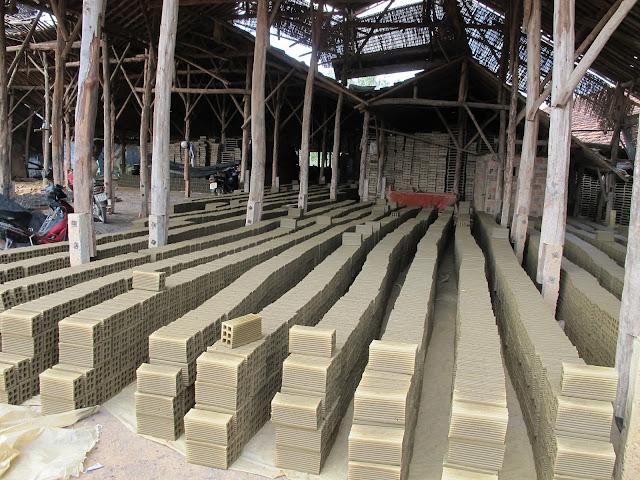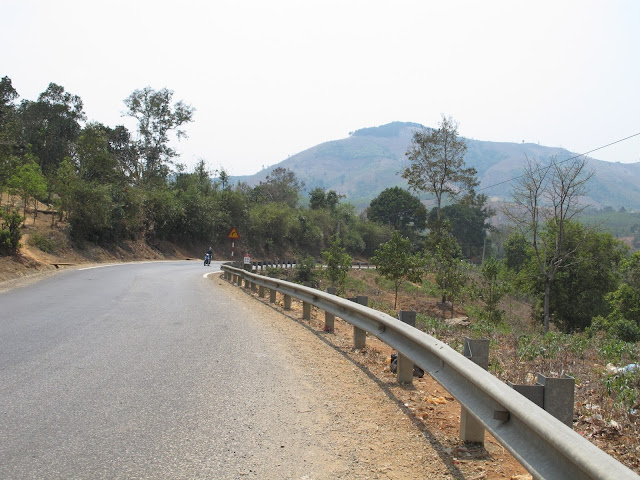Written from. . .well, actually that's a question. I've thought it was Plei Kan (or sometimes Plei Can) we were planning to spend the night in, but really, it's a town called Ngoc Hoi. Honest. They're all three the same town, Plei Kan used to work fine, but now all the signage on the ground is for Ngoc Hoi. So let's say it's Ngoc Hoi just in case any of you are planning to try to find your way here. Today is the fifth of March, twenty days to fly-away incidentally, and we're still headed away from Hanoi. . .just saying.
So if you're sure of yourself, been there, done that and all, and you're expecting Plei Kan to turn up with drums and trumpets about lunch time and you find yourself instead still rolling along at 1:00, you (might, depending I suppose) stop, dig out the road atlas and the telephone and start comparing notes between the various witnesses. In this case the big map still insists it's Plei Kan and the telephone agrees. . .and adds with a rude comment that it's 35 km back the way we came. That agrees with the km markers, which have been getting way too close to Dak Glei. The road atlas gives us the final clarification. . .it too says that Plei Can is where we were headed, but in very light type face and hidden in parentheses (who ever reads the stuff in parentheses) it drops a hint that somebody somewhere might call the town Ngoc Hoi. Right. Turn around and head back down the road.
It's more embarassing than that. Earlier in the day, passing through a nice little town I recognized a couple of restaurants and hotels and knew I'd over-nighted there once sometime in the past. . .and I came to the edge of town where the main highway makes a 90 degree turn at an intersection and remembered, from years and years ago the first time I'd come through the town. . .there'd been a soft drinks stand set up hanging its blue tarp sun shade from the nice blue and white highway sign, so all those years ago I went straight ahead and into oblivion instead of turning right and staying on the highway. That mistake soon became apparent (km markers again. . .wonderful things) and I got it sorted out. Ever since, passing that way (this is the main western north-south highway in the country) I've always grinned and remarked to myself that it's nice the soft drinks stand is elsewhere. . .the road sign is a lot easier to read this way. So I went through that whole routine and still didn't wake up to the fact I was where I was supposed to be. . .and instead just kept on rolling along. Good grief.
Actually, it was probably just fine that way. If I'd gotten into, er, Ngoc Hoi, at lunch time I might have tried to push on through to Attapeu in Laos. . .which may, or may not, have been a good thing. As it is, we're proceeding according to plan and that's fine. I made good use of the afternoon, around Ngoc Hoi. . .bought four pony tail holders for example. To explain. . .there are something like 40 million pony tails in Viet Nam at any given moment, quite a lot of them, so anywhere you stop and stand still a minute you can probably buy a pony tail holder. I got four of the thick ones that kind of bunch up around the tail. . .you've no doubt seen it done, the lady slips the thing around her wrist, grabs the hand full of hair, makes a sort of twisting, wrapping motion, some quick business with both hands and voila. . .she has the pony tail captured. Just right. It might not have worked, my wrist is a lot bigger than the average VNese lady's. . .but it's just right really. The pony tail holders will hold my shirt sleeves tightly enough the wind of our riding won't push the shirt sleeves up above the wrist, so what with gloves and shirt sleeves and the pony tail holders, the burned red wrists shouldn't get any worse the next couple of weeks. I was the one asking for sunshine, so I have nobody to blame but myself.
Is that it? Pony tail holders?? I should comment on the scenery I suppose. This is the "Central Highlands", country I never visited when I was a boy in the Army, but my impression is that in that era it was mostly mountainous forest. Now it's mountainous. Forget the forest, unless you're willing to accept rubber and banana trees and occasional fields of maize or large fields of cassava. It's sort of a potato kind of thing. . .don't know what it's really good for, but a lot of people here eat it boiled with salt and pepper or nuoc mam and hot red chile, it's mighty plain without. Tons and tons of it though are being trucked into a big modern factory as we speak, east of here a ways and they're no doubt making something out of it. Yesterday it was sugar cane. . .the same tons and tons, trucks piled up so high they really should roll over, all stacked up in front of a factory making sugar I'm pretty sure.
Anywhere there's a piece of low ground that can be flattened out and flooded you'll have little tiny stairstepped rice paddy terraces snaking down a creek bottom. Bright green right now and lovely.
Red red dirt. Also Red Brown dirt. Also a certain amount of tan dirt with a hint of red in its attitude. Where there's red dirt lots of things are sort of red. Kids' legs, motor bikes, cars, trucks and buses, houses and barns, white buildings (that is, buildings with white paint under the red dust), the lower half of power poles. . .pretty much anything. In wet weather the paved roads are deep with red mud, tracked in from every side road that isn't paved. . .which is a lot of side roads. Right now it's just red dust and it gets into everything.
The architecture in the cities is more modern than down on the coast, out in front a ways, bold color combinations, big panels of colored glass and angular color combinations spread across the facades. . .not afraid of a little color and art these people. And the towns are spread out a good bit more. Perhaps the ground isn't quite as dear here. . .if you can afford to grow rubber on it instead of rice it can't be worth as much, so the buildings have a little more room to themselves, or maybe they're just as tightly packed, but a little bigger than down on the coast. Over all it feels a lot like the American west. . .wide open spaces, bare mountainsides, bold (if a little outlandish) cities. . .a good place all told, but not much like the rest of Viet Nam until you get down into the details. The shops and markets and noodle shops are about the same, though maybe the fat noodles in the Mi Quang shops are a little nicer here. . .that's hard to say, I haven't really sampled an adequate variety yet.
I need to be up and around in the morning, it's likely to be a long day. Let's look at some photos and call it a night. Come back in a day or two and I'll get some captions on these. . .though mostly they are what they are. Note all the hostile natives.
 |
| There was an extensive brick works you could just see from the road, but when we turned off to go look at it we found it wandering deeper and deeper into the countryside. The place was all built of natural poles roofed over with their own red roofing tiles. It's just a ways west of Quy Nhon, but if anybody wants to go do a serious photo essay, here's a real topic (not boats, but still. . .). I can give you coordinates if you want. |
 |
| Loading a kiln takes 8 people in this case, 5 ladies inside doing a bucket-brigade routine passing the piles of bricks back and up onto the pile, and three people out in the warehouse fetching green brick and handing them through the opening. |
 |
| Add caption |
 |
| So here's your basic 1970's vintage Honda 50cc. . .hot rod. These things are quite highly valued, given that they were the bottom of the line when they were new. So, do a little artistic body work, rebuild the engine, put on better wheels and brakes, a fancy air cleaner and stainless pipe, get the upholstery seriously upgraded and. . .it'll sell easily for twenty million VND. To be clear, my bike, when new was worth about 10 million, and is probably down to 6 million now. |
 |
| As may be, I don't think I'll trade. . .no place to hang the saddle bags. If I had a pocket watch I could use it for a fob. |
 |
| Somewhere in, er, maybe Nevada? |
 |
| Maybe northern Baja California? |
 |
| Oops, something like this will give it away. Several different ethnic minorities build variations on this community center and I've no idea how to tell which is which. Take the photos to the Museum of Ethnology in Hanoi (a fabulous museum, even if you don't like museums at all). Maybe you can figure it out there. |
 |
| The white beams all have popular party slogans in red and gold on the other side. . .this is the quiet side for some reason. |
 |
| Here are your slogans. Look past them up into the roof structure and ponder how it works. Then try to figure out how you build such a thing without a crane or a manlift or much of anything but a gang of men who aren't afraid of heights. |
 |
| Okay, it doesn't all look like Arizona. |
 |
| Tons and tons of cassava roots to make. . .I don't know. Nice modern looking factory though. |
 |
| Lovely little shady coffee shop with almost enough Bougainvillea. |
 |
| Even though were a long ways from the sea, the Vietnamese will have fresh ocean fish whenever they can.. .carp otherwise. |
 |
| Simply wonderful variety of fresh foodstuff every day. |
 |
| And a whole flock of future chickens! |
 |
| She has fresh duck eggs, half hatched duck eggs, brown and white hen's eggs and quail eggs, and she brought them here on a motorbike. Better her than me in this case. |
 |
| Hostile natives make being out in the open a dangerous thing. |
 |
| Uh. . .". . .That One!!!" |
 |
| Grandpa's are great, everyone should have one! |
 |
| He's very uncertain about all this, but his big sister is going to show him off if it kills him. What do bald guys with beards eat anyway?? Kids?? Who says?? |





































pandora jewelry
ReplyDeletefitflops
miami dolphins jerseys
replica rolex
yeezy boost 350
coach outlet online
ralph lauren outlet
michael kors outlet online
michael kors handbags sale
nike trainers uk